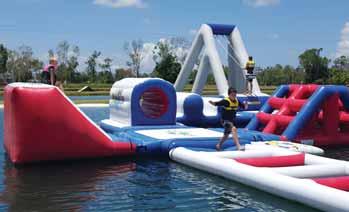
6 minute read
Can the Show go on?

The Barra Fun Park in Townsville (pictured below) was reportedly unable to secure insurance earlier this year.
Advertisement

The Small Business Ombudsman’s fi nal report calls for a Discretionary Mutual Fund as a solution for amusement and attractions insurance challenges. Nigel Benton discusses
The Australian Small Business and Family Enterprise Ombudsman, Bruce Billson, has released the final report into the insurance crisis facing Australia’s amusement, attractions and entertainment industry, declaring a Discretionary Mutual Fund (DMF) to be the most practical and durable solution to enable the industry to remain operational in a hardened global insurance market. Introducing the report, The Show Must Go On, Billson advised “right now, there is a very real possibility the show cannot go on if small businesses in the amusement and recreation sector cannot get the essential risk protection they need to operate.
“This inability to secure insurance coverage puts thousands of jobs at risk and means many of the attractions people know and love are on the brink of being a thing of the past.
“The clear and present danger is real. To put it into perspective, the sector employs over 7,000 people and contributes $1.84 billion to the economy in total.
“If these businesses cannot secure risk protection, they face imminent closure and that will lead to significant job losses -
particularly in regional areas - and a loss of economic activity generated by metro and regional shows and amusement parks. “In this light, our final report endorses the Australian Amusement, Leisure and Recreation Association’s (AALARA) proposal to establish a DMF as the only current workable solution to the immediate need for coverage in the sector.” The Show Must Go On final report, reiterates the interim report’s finding that the lack of affordable insurance arises from a range of factors amplified by the hardening global insurance market which means very few insurers are willing to cover the industry and premiums - when available - have skyrocketed. Billson, who has been particularly critical of the Coversure product available to the industry, noted “with only one insurer willing to provide coverage to these businesses, insurance premiums have risen - often by more than 200% - and many essential risk protec businesses have been refused coverage outright. “Others have stranded assets, with just some of their equipment securing insurance coverage.” Public liability insurance coverage is legally required across a range of businesses including rides at showgrounds, kids play centres, laser tag and even walking tours in national parks. This can be through contractual obligations as well as requirements imposed by state and territory governments on councils and other landowners.
DMFs operate to provide cover on a discretionary basis to a group of individuals or organisations that have a similar risk profile. Under a DMF, members who meet requirements would have access to a certificate of protection, enabling them to operate these amusement rides.
While the Australian Small Business and Family Enterprise Ombudsman (ASBFEO) recommends the establishment of a DMF as a workable and durable solution for the industry, it notes that the final report also finds this is reliant on foundational support by all levels of government.
Significantly, it does not indicate the likelihood of such funding being forthcoming or whether the industry itself might fund the startup of the DMF if governmental backing is not forthcoming.
Billson commented “a DMF requires legislative reform by all states and territories to ensure it is accepted in lieu of insurance for licensing requirements.
The reported insurance crisis in Australia’s attractions industry and related sectors could be reduced if operators adopted higher standards of risk management according to Adrian Gamble, General Manager at specialist Australian underwriting agency Coversure Pty Ltd.
Explaining that the reason insurers have pulled out of the market “is that they are not making money”, Gamble advises “over recent years there have just been too many payouts resulting from claims in the industry.”
Citing insurers having to pay out multiple claims in the “tens of thousands of dollars” resulting from incidents over recent years, Gamble explains “many operators rely on outdated risk management procedures and, with the world having moved on, they need to adopt an active approach to risk management.
“While over the last year it has frequently been said that it is impossible to insure class 4 and 5 rides, that is not true, class 4 and 5 rides are something we underwrite every day … but we insist on operators undertaking thorough and ongoing risk assessments.”
“Additionally, the DMF needs to be recognised as a suitable solution at a local level and supported by councils and showground managers.”
While the Ombudsman’s final report confirms a DMF as the most suitable solution to the insurance crisis faced by the sector, it also acknowledges there are challenges to the model, with Billson adding “a DMF is not a magic fix.
“It requires an ongoing sector-wide commitment to best practice risk mitigation measures, the need to ensure membership remains cohesive and acts in the best interests of other members and broad understanding the sector is unlikely to see coverage costs reduce in the short term.
“On balance, as the insurance crisis threatens the livelihoods of thousands of hard-working Australian small business owners along with many of the family entertainment activities that we hold dear, a DMF is the only suitable pathway forward.”
Gamble’s comments followed a recent report by A Current Affair, ‘Amusement park operators priced out by insurance hikes’, which suggested that “Luna Park (Sydney) could close, the (Sydney) Royal Easter Show is in doubt, and it could be the end of the jumping castle”.
Highlighting the rising cost of insurance in the attractions industry, A Current Affair reported that “insurance hikes are pricing amusement rides and their operators out of the market.”
Other reports have recently referred to one attraction that apparently had to close because of the high cost of insurance.
However, Australasian Leisure Management understands that the operator was offered insurance subject to the adoption of improved risk management practices. This included, as an example, having a lifeguard at the top of a waterslide to supervise guests - a change the operator declined to adopt, as a result of which his insurance was declined.
In this type of situation, Gamble explains “if an operator chooses not to follow risk management and wants to carry on activities that are not consistent with what we set out to offer, we cannot insure them. Operators have to want to reach the highest standards of risk management.
“Recent years have seen too many incidents where avoidable risks have led to incidents and the industry needs to reach ever higher standards (so) operators must constantly assess risk, commit to safety processes and procedures, educate and train their staff and underpin this with technology.”
Gamble, like the ASBFEO points out that a DMF would have limitations, explaining “a DMF is not insurance, but offers ‘discretionary cover’ in the form of an insurance-like product owned by a legally owned company and run by industry members (through a Board of Directors).”
“Even if a DMF does attract the funds to get off the ground it will still be critical for risk management practices to improve as, the Fund will need to minimise claims and payouts.
“And if the DMF doesn’t have enough funds it will have to secure them through reinsurance.”
Gamble is also critical of site owners, venues and showgrounds demanding operators have $20 million in public liability.
He goes on to say “so that insurance remains available and for the industry to deliver the highest standards of public safety and inspire guest confidence the industry must look to constantly improve its standards and should look to national risk management training that goes beyond statutory requirements and focusses on hazard identification and risk reduction.”
Risk management is the key to solving the attractions industry’s insurance crisis











